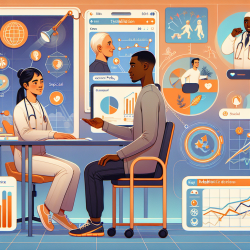Introduction
In the ever-evolving field of medical education, simulation has emerged as a pivotal tool for enhancing clinical learning experiences. The research article "Residents’ perceptions of simulation as a clinical learning approach" provides valuable insights into how simulation is perceived by trainees and offers guidance on optimizing its use for educational purposes. As practitioners in speech-language pathology and other medical fields, understanding these perceptions can help refine our approaches to simulation-based learning.
The Power of Simulation
Simulation offers a unique platform for practicing clinical skills in a controlled, risk-free environment. According to the research, trainees value simulation for its pragmatic purposes, particularly in technical skills training. This perception underscores the importance of simulation in laying the foundation for clinical competencies, allowing trainees to familiarize themselves with equipment and procedures without the pressures of real-life clinical settings.
Beyond Technical Skills
While the research highlights the focus on technical skills, it also reveals a gap in utilizing simulation for non-technical skills development. Trainees often view simulation narrowly, missing opportunities to enhance communication, decision-making, and leadership skills. As educators, we must broaden the scope of simulation-based learning to encompass these critical competencies, ensuring a holistic approach to training.
Creating a Safe Learning Environment
Simulation provides a safe space for trainees to learn, explore, and make mistakes without compromising patient safety. This environment encourages active learning and problem-solving, fostering a learner-centered approach. By emphasizing the safety and exploratory nature of simulation, educators can enhance trainee engagement and confidence.
Designing Effective Simulation Experiences
Optimal simulation design involves integrating simulation meaningfully within the curriculum. Trainees in the study expressed the need for simulation to be closely linked with clinical practice, allowing for seamless transition and application of skills. Educators should aim to design simulation experiences that align with real-world clinical scenarios, providing relevant and practical learning opportunities.
Addressing Perils and Pitfalls
The research also highlights potential pitfalls of simulation, such as the risk of ingraining "bad habits" or fostering overconfidence. To mitigate these risks, feedback and supervision are crucial components of simulation-based learning. Educators must ensure that simulation tasks closely mimic real-life situations and provide constructive feedback to guide trainees in refining their skills.
Conclusion
Simulation holds immense potential to transform clinical learning, offering a versatile platform for skill development. By addressing the perceptions and expectations of trainees, educators can optimize simulation-based education to encompass both technical and non-technical skills. This holistic approach not only enhances learning outcomes but also prepares trainees for the complexities of real-world clinical practice.
To read the original research paper, please follow this link: Residents’ perceptions of simulation as a clinical learning approach.










